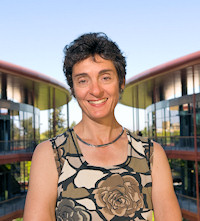 |
Carla ShatzProfessor of Biology and Neurobiology Director, Bio-X, Stanford University Audio and slides from the 2010 Keynote Address are available on the Cambridge Research Systems website. |
Releasing the Brake on Ocular Dominance Plasticity
Saturday, May 8, 2010, 7:45 pm, Royal Palm Ballroom 4-5
Connections in adult visual system are highly precise, but they do not start out that way. Precision emerges during critical periods of development as synaptic connections remodel, a process requiring neural activity and involving regression of some synapses and strengthening and stabilization of others. Activity also regulates neuronal genes; in an unbiased PCR-based differential screen, we discovered unexpectedly that MHC Class I genes are expressed in neurons and are regulated by spontaneous activity and visual experience (Corriveau et al, 1998; Goddard et al, 2007). To assess requirements for MHCI in the CNS, mice lacking expression of specific MHCI genes were examined. Synapse regression in developing visual system did not occur, synaptic strengthening was greater than normal in adult hippocampus, and ocular dominance (OD) plasticity in visual cortex was enhanced (Huh et al, 2000; Datwani et al, 2009). We searched for receptors that could interact with neuronal MHCI and carry out these activity-dependent processes. mRNA for PirB, an innate immune receptor, was found highly expressed in neurons in many regions of mouse CNS. We generated mutant mice lacking PirB function and discovered that OD plasticity is also enhanced (Syken et al., 2006), as is hippocampal LTP. Thus, MHCI ligands signaling via PirB receptor may function to “brake” activity- dependent synaptic plasticity. Together, results imply that these molecules, thought previously to function only in the immune system, may also act at neuronal synapses to limit how much- or perhaps how quickly- synapse strength changes in response to new experience. These molecules may be crucial for controlling circuit excitability and stability in developing as well as adult brain, and changes in their function may contribute to developmental disorders such as Autism, Dyslexia and even Schizophrenia.
Supported by NIH Grants EY02858, MH071666, the Mathers Charitable Foundation and the Dana Foundation
Biography
Carla Shatz is professor of biology and neurobiology and director of Bio-X at Stanford University. Dr. Shatz’s research focuses on the development of the mammalian visual system, with an overall goal of better understanding critical periods of brain wiring and developmental disorders such as autism, dyslexia and schizophrenia, and also for understanding how the nervous and immune systems interact. Dr. Shatz graduated from Radcliffe College in 1969 with a B.A. in Chemistry. She was honored with a Marshall Scholarship to study at University College London, where she received an M.Phil. in Physiology in 1971. In 1976, she received a Ph.D. in Neurobiology from Harvard Medical School, where she studied with Nobel Laureates David Hubel and Torsten Wiesel. During this period, she was appointed as a Harvard Junior Fellow. From 1976 to 1978 she obtained postdoctoral training with Dr. Pasko Rakic in the Department of Neuroscience, Harvard Medical School. In 1978, Dr. Shatz moved to Stanford University, where she attained the rank of Professor of Neurobiology in 1989. In 1992, she moved her laboratory to the University of California, Berkeley, where she was Professor of Neurobiology and an Investigator of the Howard Hughes Medical Institute. In 2000, she assumed the Chair of the Department of Neurobiology at Harvard Medical School as the Nathan Marsh Pusey Professor of Neurobiology. Dr. Shatz received the Society for Neuroscience Young Investigator Award in 1985, the Silvo Conte Award from the National Foundation for Brain Research in 1993, the Charles A. Dana Award for Pioneering Achievement in Health and Education in 1995, the Alcon Award for Outstanding Contributions to Vision Research in 1997, the Bernard Sachs Award from the Child Neurology Society in 1999, the Weizmann Institute Women and Science Award in 2000 and the Gill Prize in Neuroscience in 2006. In 1992, she was elected to the American Academy of Arts and Sciences, in 1995 to the National Academy of Sciences, in 1997 to the American Philosophical Society, and in 1999 to the Institute of Medicine. In 2009 she received the Salpeter Lifetime achievement award from the Society for Neuroscience.
